Swedish (but naturalized Italian) film actress Anita Ekberg has passed away today. As Miss Sweden 1950, she was contracted by Howard Hughes, had a Hollywood career in the 1950s, but got her real breakthrough in Italy. She made film history as the sensual, curvaceous film goddess who dances in the Trevi Fountain in Fellini’s La Dolce Vita (1960). She was also unforgettable as a sexy billboard figure coming to life in Fellini's short film La Tentazioni del Dottor Antonio/The Temptation of Doctor Antonio (1962). Anita Ekberg was 83 years old.
![Anita Ekberg, Boccaccio '70]()
East-German postcard by VEB Progress FilmVertrieb, Berlin, no. 2391, 1965. Photo: publicity still for Boccaccio '70 (Federico Fellini, 1962).
![Anita Ekberg (1931-2015)]()
German postcard by ISV, no. F 10.
![Anita Ekberg]()
German postcard by ISV, no. D 8. Photo: Pierluigi.
![Anita Ekberg]()
German postcard by Kolibri-Verlag, Minden/Westf., no. 150.
![Anita Ekberg]()
German postcard by ISV, Sort. VI/6.
![Anita Ekberg]()
Collector's card, no. 668. Photo: Paramount.
Kerstin Anita Marianne Ekberg was born in Malmö, Sweden in 1931. She grew up with seven brothers and sisters. Having six brothers around surely developed a fierce independent spirit.
In her teens, she worked as a fashion model, and in 1951 she was elected Miss Sweden. That year she also made her film début in the film journal Terras fönster nr 5/Terra Journal No. 5 (Olle Ekelund, 1951), and she went to the US for the Miss Universe contest, despite not speaking English. She didn't win but she got a modelling contract.
Film mogul Howard Hughes gave her a contract with RKO but it didn't lead anywhere. Anita herself later claimed that Hughes wanted to marry her. Instead the voluptuous, husky-voiced blonde started making films for Universal.
Her American début was as a Venusian guard in Abbott and Costello Go to Mars (Charles Lamont, 1953). This was soon followed by The Golden Blade (Nathan Juran, 1953) starring Rock Hudson. These were small roles that only required her to look beautiful. She was given the nickname ‘The Iceberg’ - a play on her name as well as her cool, quite mysterious demeanour.
While at Universal, Anita Ekberg quickly became one of Hollywood’s hot starlets. She caught the hearts of many famous men including Tyrone Power, Errol Flynn, Frank Sinatra and Gary Cooper. Legendary director and photographer Russ Meyer called her 'the most beautiful woman he ever photographed' and said that her 40D bust line was 'the most ample in A list Hollywood history, dwarfing rivals like Jayne Mansfield'.
Soon she became a major pin up girl for the new type of men's magazine such as Playboy that proliferated in the 1950s. Ekberg also knew how to play the Hollywood tabloids and gossip columnists, creating stunts that she hoped would translate into film roles. Famously, she admitted that an incident where her dress burst open in the lobby of London's Berkeley Hotel was pre-arranged with a photographer.
Her two marriages also gave her a lot of attention from the press. She married and divorced British actor Anthony Steel (1956-1959) and actor Rik Van Nutter (1963-1975). And she reportedly had a three-year affair with the late Fiat chairman Gianni Agnelli.
The press also loved her saucy quotes, like: “I'm very proud of my breasts, as every woman should be. It's not cellular obesity. It's womanliness.”
![Anita Ekberg]()
French postcard by Editions du Globe (EDUG), no. 521. Photo: Paramount.
![Anita Ekberg]()
French postcard by Editions P.I., Paris, no. 781. Photo: Paramount.
![Anita Ekberg]()
German postcard by WS-Druck, Wanne-Eickel, no. 203. Photo: dpa.
![Anita Ekberg]()
German postcard by WS-Druck, Wanne-Eickel, no. 181. Photo: dpa.
![Anita Ekberg]()
East-German postcard by VEB Progress Film-vertrieb, Berlin, no. 3171, 1968. Retail price: 0,20 M. Photo: Pierluigi.
![Anita Ekberg (1931-2015)]()
Big East-German card by VEB Progress Film-Vertrieb, Berlin, no. 262/69.
Anita Ekberg would get several offers from other studios than Universal. Bob Hope joked that her parents had received the Nobel Prize for architecture when he was touring with her and William Holden to entertain US troops in 1954.
The tour led her to a contract with John Wayne's Batjac Productions. Wayne cast her in Blood Alley (William A. Wellman, 1955), a small role where Ekberg's features and appearance were Orientalized to play a Chinese woman. The role earned her a Golden Globe award.
Paramount Pictures then cast her in the funny comedies Artists and Models (Frank Tashlin, 1955) and Hollywood or Bust (Frank Tashlin, 1956), both starring Dean Martin and Jerry Lewis. These films showed off her stunning body but also used her as a foil for many of the director's clever sight gags.
In 1956, Ekberg went to Rome to make War and Peace (King Vidor, 1956) co-starring Audrey Hepburn. RKO gave Ekberg the female lead in Back from Eternity (John Farrow, 1956), co-starring with Robert Ryan and Rod Steiger. Ekberg was perfectly adequate in her cardboard role, and suggested that with a good director and a worthwhile part, she might have something to offer.
In the British production Zarak (Terence Young, 1956) starring Victor Mature and Michael Wilding, her sexy harem-girl dance raised many eyebrows and blood pressures. With Bob Hope she made two minor comedies, Paris Holiday (Gerd Oswald, 1958) and Call Me Bwana (Gordon Douglas, 1963).
One of her better films of this period was the film noir Screaming Mimi (Gerd Oswald, 1958). At IMDb, reviewer Lazarillo calls it one of "the missing link between American film noir and the suspense and horror films that would become so popular in continental Europe over the next two decades (i.e. the German 'krimis', the Italian 'gialli', the horror films of Bava and Argento). It's technically a late period film noir, but rather than having the traditional pessimistic tone and hard-boiled, voice-over narrative, it is completely off-the-wall and chock-full of the suggested depravity and lurid psycho-babble that would characterize the later European films. Interestingly, it was apparently based on the same Fredric Brown novel as Dario Argento's Bird with Crystal Plummage."
![Anita Ekberg]()
Vintage postcard.
![Anita Ekberg]()
French postcard by De Marchi Frères, Marseille.
![Anita Ekberg]()
German postcard by ISV, no. H 23.
![Anita Ekberg]()
German postcard by WS-Druck, Wanne-Eickel. Photo: Klaus Collignon.
![Anita Ekberg]()
French postcard by EDUG, no. 151.
![Anita Ekberg]()
Italian postcard by Rotalcolor, Milano, no. N. 51.
In 1960 Anita Ekberg found herself again in Rome for her greatest role. She played the unattainable ‘dream woman’ Sylvia opposite Marcello Mastroianni in Federico Fellini's La Dolce Vita/The Sweet Life (1960). La Dolce Vita was a sensational success, and Ekberg's uninhibited cavorting in Rome's Trevi Fountain remains one of the most memorable screen images ever captured.
Thus began a period when Ekberg would work almost exclusively in Europe. La Dolce Vita was followed by another memorable role for Fellini in his segment La Tentazioni del Dottor Antonio/The Temptation of Doctor Antonio of the anthology film Boccaccio '70 (1962). She plays a gigantic voluptuous lady on a billboard poster, promoting to drink milk and attracting huge crowds. At night she comes to live and pesters the little censor, played by Peppino De Filippo.
Fellini would later call her back for two more films: I Pagliacci/I clowns (Federico Fellini, 1972), and Intervista (Federico Fellini, 1987).
In 1964 she returned to Sweden to appear in Bo Widerberg's Kärlek 65/Love 65 (1965), but she cancelled her appearance and called the acclaimed director ‘an amateur’.
In 1967 she co-starred with Shirley MacLaine in a segment of Vittorio de Sica’s Woman Times Seven (1967). For much of the 1960s though, she was trapped in substandard genre fare and lame comedies.
During the 1970s the roles became less frequent. In 1982, at the age of 50 she posed for glamour photos but in 1987, twenty-seven years after La Dolce Vita, she made a marvellous comeback with Fellini's filmic autobiography, Intervista (Federico Fellini, 1987), where she played herself in a reunion scene with Mastroianni and watched film clips of herself during her heydays. In 1995 Empire magazinechose her as one of the 100 Sexiest Stars in film history (#98).
While she remained active in films into the 1990s, the roles were hardly memorable. Exceptions came with her portrayal of an elderly restaurant owner who is killed in a gas explosion in Bámbola/Doll (Bigas Luna, 1996) featuring Valeria Marini, and her role as an ageing, flamboyant opera star who succumbs to the charms of the titular character in Le nain rouge/The Red Dwarf (Yvan Lemoine, 1998). Still blonde, but a bit heavier, Ekberg was able to project the requisite sensuality and diva-like behaviour resulting in a full-bodied performance that ranked among her best.
Her last role in a TV series was in Il bello delle donne/The beautiful one of the women (2002) starring Stefania Sandrelli.
Anita Ekberg has not lived in Sweden since the early 1950s and rarely visited the country. She has welcomed Swedish journalists in her house outside Rome, and in 2005 appeared in the popular radio program Sommar, talking about her life. She stated in an interview that she would never move back to Sweden until she died, when she will be buried there.
Today, 11 January 2015, Anita Ekberg died at the clinic San Raffaele in Rocca di Papa, Italy. Her death was caused by complications from a long-time illness. She was 83.
![Anita Ekberg]()
Yugoslavian postcard by Studio Sombor, no. 270.
![Anita Ekberg (1931-2015)]()
German postcard by Ufa, Berlin-Tempelhof, no. FK 3590. Photo: Columbia Film. Publicity still for Interpol (John Gilling, 1957).
Trailer Artists and Models (1955). Source: Arnold Zieffel (YouTube).
Anita does a sexy dance in the thriller Screaming Mimi (1958). Source: Bachflat (YouTube).
The famous Trevi Gountain scene in La dolce vita (1960). Source: Julia Barnum (YouTube).
Trailer Intervista (1987). Source: Buen Cine Dvd (YouTube).
Sources: Hal Erickson (Rovi), Mattias Thuresson (IMDb), Java’s Bachelor Pad, TCM, Wikipedia, and IMDb.
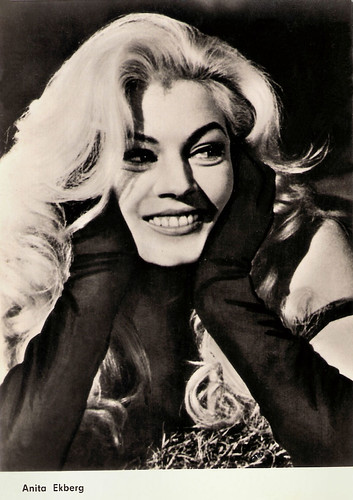
East-German postcard by VEB Progress FilmVertrieb, Berlin, no. 2391, 1965. Photo: publicity still for Boccaccio '70 (Federico Fellini, 1962).
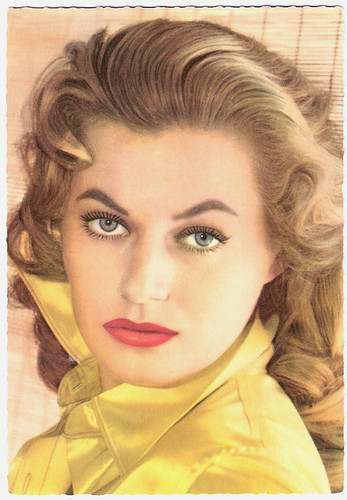
German postcard by ISV, no. F 10.

German postcard by ISV, no. D 8. Photo: Pierluigi.
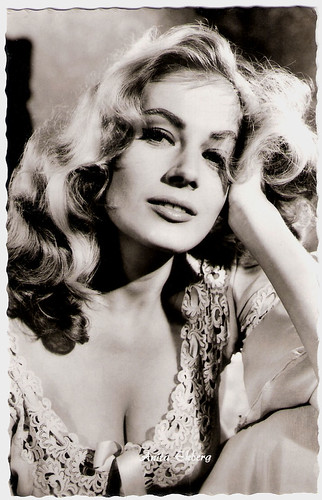
German postcard by Kolibri-Verlag, Minden/Westf., no. 150.
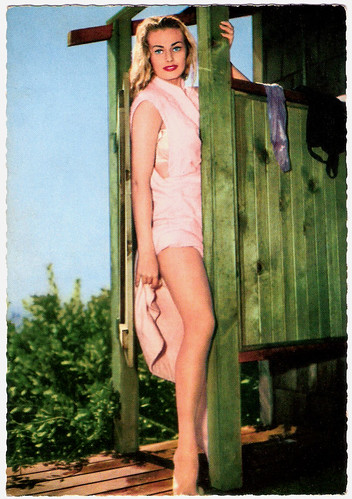
German postcard by ISV, Sort. VI/6.
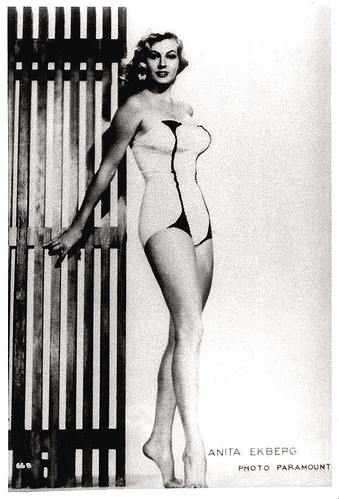
Collector's card, no. 668. Photo: Paramount.
Miss Sweden
Kerstin Anita Marianne Ekberg was born in Malmö, Sweden in 1931. She grew up with seven brothers and sisters. Having six brothers around surely developed a fierce independent spirit.
In her teens, she worked as a fashion model, and in 1951 she was elected Miss Sweden. That year she also made her film début in the film journal Terras fönster nr 5/Terra Journal No. 5 (Olle Ekelund, 1951), and she went to the US for the Miss Universe contest, despite not speaking English. She didn't win but she got a modelling contract.
Film mogul Howard Hughes gave her a contract with RKO but it didn't lead anywhere. Anita herself later claimed that Hughes wanted to marry her. Instead the voluptuous, husky-voiced blonde started making films for Universal.
Her American début was as a Venusian guard in Abbott and Costello Go to Mars (Charles Lamont, 1953). This was soon followed by The Golden Blade (Nathan Juran, 1953) starring Rock Hudson. These were small roles that only required her to look beautiful. She was given the nickname ‘The Iceberg’ - a play on her name as well as her cool, quite mysterious demeanour.
While at Universal, Anita Ekberg quickly became one of Hollywood’s hot starlets. She caught the hearts of many famous men including Tyrone Power, Errol Flynn, Frank Sinatra and Gary Cooper. Legendary director and photographer Russ Meyer called her 'the most beautiful woman he ever photographed' and said that her 40D bust line was 'the most ample in A list Hollywood history, dwarfing rivals like Jayne Mansfield'.
Soon she became a major pin up girl for the new type of men's magazine such as Playboy that proliferated in the 1950s. Ekberg also knew how to play the Hollywood tabloids and gossip columnists, creating stunts that she hoped would translate into film roles. Famously, she admitted that an incident where her dress burst open in the lobby of London's Berkeley Hotel was pre-arranged with a photographer.
Her two marriages also gave her a lot of attention from the press. She married and divorced British actor Anthony Steel (1956-1959) and actor Rik Van Nutter (1963-1975). And she reportedly had a three-year affair with the late Fiat chairman Gianni Agnelli.
The press also loved her saucy quotes, like: “I'm very proud of my breasts, as every woman should be. It's not cellular obesity. It's womanliness.”
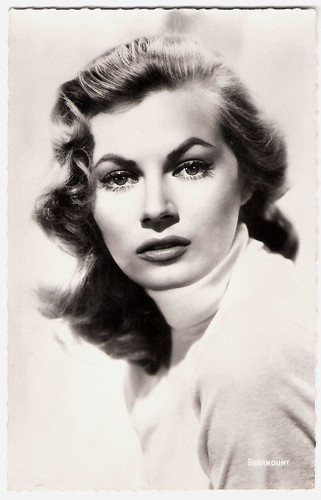
French postcard by Editions du Globe (EDUG), no. 521. Photo: Paramount.
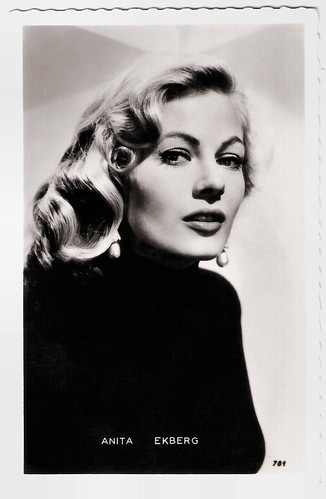
French postcard by Editions P.I., Paris, no. 781. Photo: Paramount.
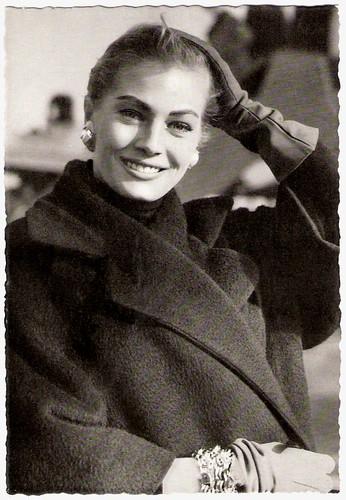
German postcard by WS-Druck, Wanne-Eickel, no. 203. Photo: dpa.
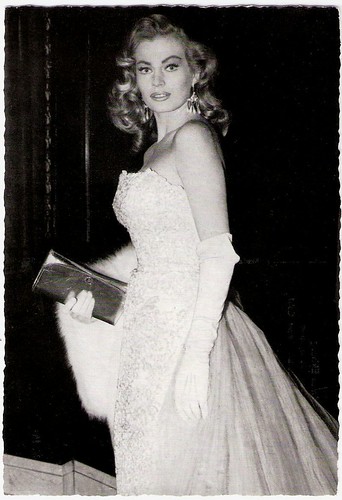
German postcard by WS-Druck, Wanne-Eickel, no. 181. Photo: dpa.
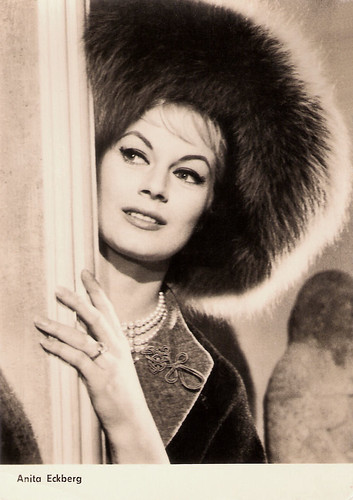
East-German postcard by VEB Progress Film-vertrieb, Berlin, no. 3171, 1968. Retail price: 0,20 M. Photo: Pierluigi.
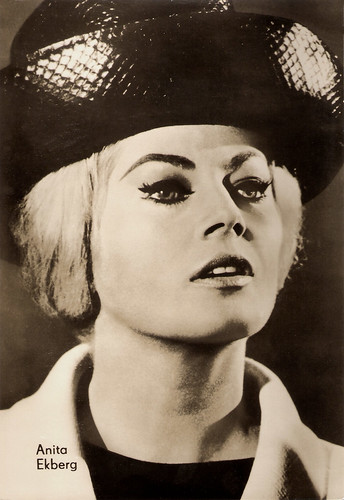
Big East-German card by VEB Progress Film-Vertrieb, Berlin, no. 262/69.
Foil for Sight Gags
Anita Ekberg would get several offers from other studios than Universal. Bob Hope joked that her parents had received the Nobel Prize for architecture when he was touring with her and William Holden to entertain US troops in 1954.
The tour led her to a contract with John Wayne's Batjac Productions. Wayne cast her in Blood Alley (William A. Wellman, 1955), a small role where Ekberg's features and appearance were Orientalized to play a Chinese woman. The role earned her a Golden Globe award.
Paramount Pictures then cast her in the funny comedies Artists and Models (Frank Tashlin, 1955) and Hollywood or Bust (Frank Tashlin, 1956), both starring Dean Martin and Jerry Lewis. These films showed off her stunning body but also used her as a foil for many of the director's clever sight gags.
In 1956, Ekberg went to Rome to make War and Peace (King Vidor, 1956) co-starring Audrey Hepburn. RKO gave Ekberg the female lead in Back from Eternity (John Farrow, 1956), co-starring with Robert Ryan and Rod Steiger. Ekberg was perfectly adequate in her cardboard role, and suggested that with a good director and a worthwhile part, she might have something to offer.
In the British production Zarak (Terence Young, 1956) starring Victor Mature and Michael Wilding, her sexy harem-girl dance raised many eyebrows and blood pressures. With Bob Hope she made two minor comedies, Paris Holiday (Gerd Oswald, 1958) and Call Me Bwana (Gordon Douglas, 1963).
One of her better films of this period was the film noir Screaming Mimi (Gerd Oswald, 1958). At IMDb, reviewer Lazarillo calls it one of "the missing link between American film noir and the suspense and horror films that would become so popular in continental Europe over the next two decades (i.e. the German 'krimis', the Italian 'gialli', the horror films of Bava and Argento). It's technically a late period film noir, but rather than having the traditional pessimistic tone and hard-boiled, voice-over narrative, it is completely off-the-wall and chock-full of the suggested depravity and lurid psycho-babble that would characterize the later European films. Interestingly, it was apparently based on the same Fredric Brown novel as Dario Argento's Bird with Crystal Plummage."
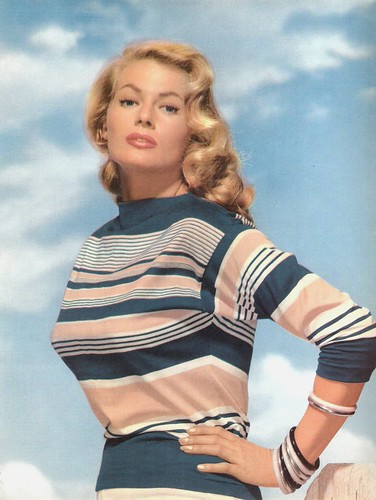
Vintage postcard.
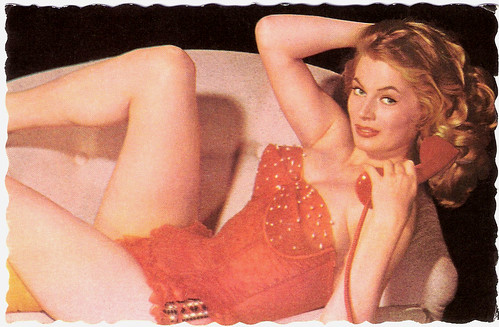
French postcard by De Marchi Frères, Marseille.
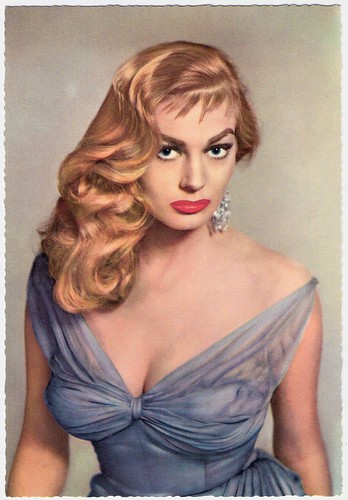
German postcard by ISV, no. H 23.
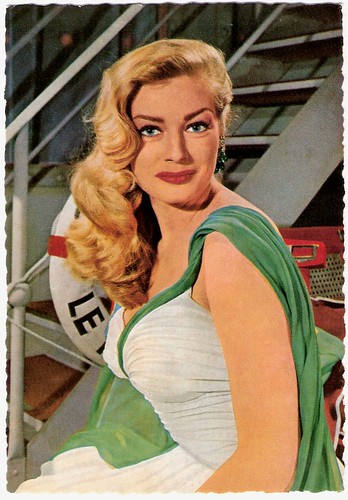
German postcard by WS-Druck, Wanne-Eickel. Photo: Klaus Collignon.
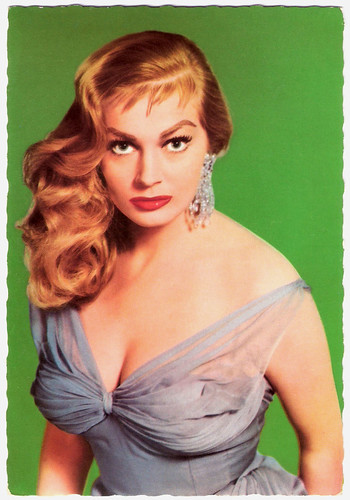
French postcard by EDUG, no. 151.
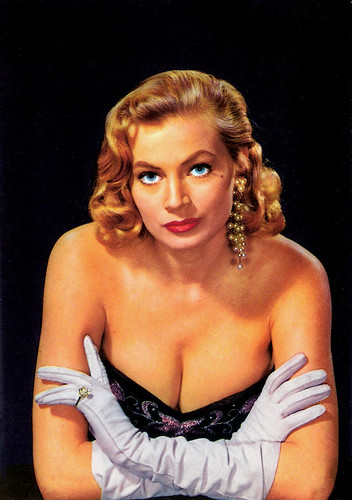
Italian postcard by Rotalcolor, Milano, no. N. 51.
The Sweet Life
In 1960 Anita Ekberg found herself again in Rome for her greatest role. She played the unattainable ‘dream woman’ Sylvia opposite Marcello Mastroianni in Federico Fellini's La Dolce Vita/The Sweet Life (1960). La Dolce Vita was a sensational success, and Ekberg's uninhibited cavorting in Rome's Trevi Fountain remains one of the most memorable screen images ever captured.
Thus began a period when Ekberg would work almost exclusively in Europe. La Dolce Vita was followed by another memorable role for Fellini in his segment La Tentazioni del Dottor Antonio/The Temptation of Doctor Antonio of the anthology film Boccaccio '70 (1962). She plays a gigantic voluptuous lady on a billboard poster, promoting to drink milk and attracting huge crowds. At night she comes to live and pesters the little censor, played by Peppino De Filippo.
Fellini would later call her back for two more films: I Pagliacci/I clowns (Federico Fellini, 1972), and Intervista (Federico Fellini, 1987).
In 1964 she returned to Sweden to appear in Bo Widerberg's Kärlek 65/Love 65 (1965), but she cancelled her appearance and called the acclaimed director ‘an amateur’.
In 1967 she co-starred with Shirley MacLaine in a segment of Vittorio de Sica’s Woman Times Seven (1967). For much of the 1960s though, she was trapped in substandard genre fare and lame comedies.
During the 1970s the roles became less frequent. In 1982, at the age of 50 she posed for glamour photos but in 1987, twenty-seven years after La Dolce Vita, she made a marvellous comeback with Fellini's filmic autobiography, Intervista (Federico Fellini, 1987), where she played herself in a reunion scene with Mastroianni and watched film clips of herself during her heydays. In 1995 Empire magazinechose her as one of the 100 Sexiest Stars in film history (#98).
While she remained active in films into the 1990s, the roles were hardly memorable. Exceptions came with her portrayal of an elderly restaurant owner who is killed in a gas explosion in Bámbola/Doll (Bigas Luna, 1996) featuring Valeria Marini, and her role as an ageing, flamboyant opera star who succumbs to the charms of the titular character in Le nain rouge/The Red Dwarf (Yvan Lemoine, 1998). Still blonde, but a bit heavier, Ekberg was able to project the requisite sensuality and diva-like behaviour resulting in a full-bodied performance that ranked among her best.
Her last role in a TV series was in Il bello delle donne/The beautiful one of the women (2002) starring Stefania Sandrelli.
Anita Ekberg has not lived in Sweden since the early 1950s and rarely visited the country. She has welcomed Swedish journalists in her house outside Rome, and in 2005 appeared in the popular radio program Sommar, talking about her life. She stated in an interview that she would never move back to Sweden until she died, when she will be buried there.
Today, 11 January 2015, Anita Ekberg died at the clinic San Raffaele in Rocca di Papa, Italy. Her death was caused by complications from a long-time illness. She was 83.

Yugoslavian postcard by Studio Sombor, no. 270.
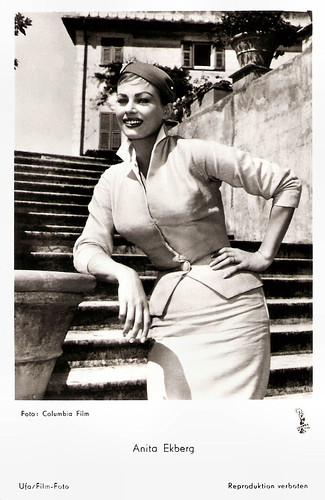
German postcard by Ufa, Berlin-Tempelhof, no. FK 3590. Photo: Columbia Film. Publicity still for Interpol (John Gilling, 1957).
Trailer Artists and Models (1955). Source: Arnold Zieffel (YouTube).
Anita does a sexy dance in the thriller Screaming Mimi (1958). Source: Bachflat (YouTube).
The famous Trevi Gountain scene in La dolce vita (1960). Source: Julia Barnum (YouTube).
Trailer Intervista (1987). Source: Buen Cine Dvd (YouTube).
Sources: Hal Erickson (Rovi), Mattias Thuresson (IMDb), Java’s Bachelor Pad, TCM, Wikipedia, and IMDb.